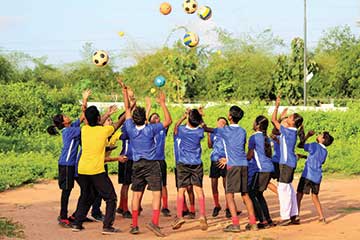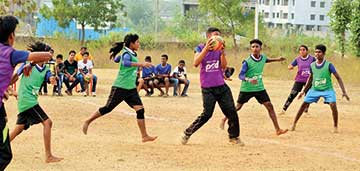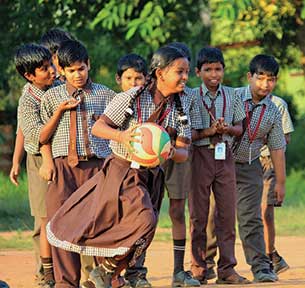Suheil F. Tandon
The United Nations Educational, Scientific and Cultural Organization (UNESCO) adopted the International Charter of Physical Education, Physical Activity and Sports way back in 1978, which explicitly states that, “Every human being has a fundamental right to physical education, physical activity and sport, without discrimination.”1 Moreover, it recognizes the holistic impact of physical education and sports on the physical, mental and social well-being of participants and communities. With these global guidelines by UNESCO as the backdrop, I explore how physical education in India has fared in the past and identify a roadmap for future development of the subject across education institutions.
 Current status of PE
Current status of PE
My earliest recollection of physical education (PE) in school is from participating in early morning mass physical training drills as part of our daily routine during the mid 1990s. Over the next few years, PE evolved in schools as a subject to incorporate a wider approach to learning and enjoying various sports and games, during periods reserved within the school timetable most commonly known as the “games period”. At the turn of the 21st century however, the focus shifted towards training school students to excel in competitive sport. This new focus is evident from the Sarva Shiksha Abhiyan or universal education program initiated by the Indian government in early 2000, where schools were encouraged to include sports in their curriculum but made no specific reference to physical education2. This shift fits into a larger socio-economic and political discourse around India excelling on the global sporting stage. The focus on ‘excelling in sport for medals’ has only strengthened since India’s success at Beijing 2008.
The sport for excellence approach has blurred the lines between sport and PE in the education system. The focus on competitive sport has limited the outreach that PE has in schools, as it is based on the premise of training the talented few, hence decreasing the number of students actively engaged in physical activity. This has also led to the establishment of a vast number of after-school sports academies catering to school children interested in pursuing sport.
The last decade has also seen the growth of a number of private companies and organizations that are implementing well-researched and structured PE programmes in partnership with private schools. This has increased the overall quality of PE in schools as compared to a few decades ago. Yet the end goal of these programmes continues to be aligned with the country’s obsession with talent identification and winning medals, rather than on the benefits of PE for children’s health and holistic well-being.
In 2018, PE was made compulsory by the Central Board of Secondary Education (CBSE) for standard IX to XII3. CBSE has mandated schools to ensure one period per day for all students for PE, and has directed schools to ensure marks or grades are submitted for the subject. The Union Government also proposed the Samagra Shiksha Abhiyan in 2018, which envisions a holistic approach to education, with sports and PE as a major component4. These are positive steps towards the sustainable integration of PE with school curriculums, and I am confident other education boards and authorities will follow. However, some questions arise as to the strategies adopted for the same. Why has PE not been made compulsory for all school students, from standard I to XII? If the idea was to start with a pilot for making PE compulsory in schools, why not start with the younger classes, where there is a greater need for PE and students have more time to devote to it? Moreover, are there any standardized assessment tools to grade students participating in PE? How do we measure the social, emotional and mental benefits of PE? In seeking answers to these questions, India can learn a lot from different global approaches to PE within educational systems.
 Global approaches to PE
Global approaches to PE
The Collins dictionary defines PE as “instruction in physical exercise and in the care and hygiene of the human body”5. A similar approach to this definition is adopted by the education boards of several countries, including New Zealand, Hong Kong and Canada, where the subject is known as “Health and PE”. The New Zealand school curriculum delivers Health and PE with four aims: personal health and physical development, movement concepts and motor skills, relationships with other people and healthy communities and environment6. The International Baccalaureate, a globally renowned education system, defines Health and PE as “both learning about and learning through physical activity”7. Moreover, in most of these cases, Health and PE is compulsory for students, at least up to middle school, if not beyond.
A striking similarity in the definitions of PE adopted by these education boards in different countries is that there is no mention of sports. This is because PE incorporates a much wider scope of activities, of which sports is only one component. This is important to acknowledge, as PE in India is currently equated to sports coaching. This limits the impact of the subject on the students and reduces the interest of a large proportion of students. Another similarity in the approaches mentioned above is that the subject aims to achieve a wide variety of outcomes such as being physically active achieving good health and well-being, learning about personal health and hygiene as well as building soft skills that will help relate to other people.
A new concept which has recently been introduced into the nomenclature of PE, known as ‘physical literacy’, captures well the essence of the definitions above, and in my view, this is where PE is headed in the future. The International Physical Literacy Association defines the term as “the motivation, confidence, physical competence, knowledge, and understanding to value and take responsibility for engagement in physical activities for life”8. This starts by learning fundamental movement skills (or what we call general motor skills) at a young age to develop the self-confidence and motivation to become physically active. Physical literacy is just as integral to a child’s early development as is numeric literacy and functional language skills – hence the need for it to be incorporated into PE classes and within the formal education curriculum from a young age.
Future roadmap
Being one of the youngest countries in the world, with a large and growing adolescent population, India is in a unique position to demonstrate transformative leadership in promoting the wide-ranging benefits of physical activity through the education system. This transformation needs to be driven through our primary and secondary education institutions, which are in the best position to make systemic and long-term changes to make PE relevant, impactful and sustainable. This has to start with the recognition of PE as a compulsory school subject for children just as math, social studies and languages are, from pre-primary school all the way up until high school. PE must also be recognized as a distinctive subject separate from sports, and its parameters clearly outlined, encompassing best practices globally while remaining culturally and locally relevant. I strongly believe that a quality PE program must focus on achieving outcomes in physical and mental health and wellbeing, soft skill development as well as mastering of fundamental movement skills. To bring about these changes, the support of various stakeholders across the education system will be required, including schools and teachers, parents and students, universities offering PE courses, school boards, government authorities and the sports and fitness industry.
 These initial changes to the outlook of PE in the education system should be followed with the identification, development and aligning of strategies for PE programmes in schools, with the collaboration and inputs of all the stakeholders outlined above. This will ensure a consolidated approach to PE within India’s educational system, capable of achieving consistent outcomes across different age groups. This will involve standardizing frameworks of PE curricula as well as delivery, monitoring and evaluation methodologies. In a country as diverse as India, with an education system comprising complex private and public school systems, the standardization of PE as a subject is easier said than done. This will require a major effort with the collaboration of different stakeholders and a long-term commitment.
These initial changes to the outlook of PE in the education system should be followed with the identification, development and aligning of strategies for PE programmes in schools, with the collaboration and inputs of all the stakeholders outlined above. This will ensure a consolidated approach to PE within India’s educational system, capable of achieving consistent outcomes across different age groups. This will involve standardizing frameworks of PE curricula as well as delivery, monitoring and evaluation methodologies. In a country as diverse as India, with an education system comprising complex private and public school systems, the standardization of PE as a subject is easier said than done. This will require a major effort with the collaboration of different stakeholders and a long-term commitment.
A consolidated, systemic and standardized approach to PE will only be successful if schools have the capacity to effectively deliver such programmes. This means ensuring that both public and private schools have adequate playgrounds, sporting infrastructure, equipment as well as skilled personnel to deliver sound PE programmes. To ensure schools have skilled personnel, the number of higher education institutions providing PE as a degree subject will need to increase, as currently there are not enough to meet the demand of the large number of schools in the country. Moreover, the course structure and learning outcomes of these degree courses will need to be aligned with the new approach to PE adopted by India’s education system.
Finally, to ensure that there is buy-in from different stakeholders to work towards transforming PE in schools, advocacy at each stage of the process about the emerging trends and the holistic benefits of PE will be extremely important. Stakeholders must be informed about the impact of a well-rounded PE programme. This can be done by sharing case studies and impact stories of best practices from around the world.
India is currently at the crossroads between sporting excellence and physical education, with systems not clearly defined as to how physical education transitions into sporting excellence. The balance needs to shift towards physical education in order to ensure that every child is provided with his/her fundamental right to play and to participate in physical activity.
References
- http://portal.unesco.org/en/ev.php-URL_ID=13150&URL_DO=DO_TOPIC&URL_SECTION=201.html.
- https://www.educationforallinindia.com/SSA1.htm.
- https://timesofindia.indiatimes.com/home/education/news/cbse-makes-health-physical-education-must-for-std-ix-to-xii/articleshow/63873756.cms.
- http://samagra.mhrd.gov.in/features.html.
- https://www.collinsdictionary.com/dictionary/english/physical-education.
- http://nzcurriculum.tki.org.nz/The-New-Zealand-Curriculum/Health-and-physical-education/Learning-area-structure.
- https://www.ibo.org/programmes/middle-years-programme/curriculum/physical-and-health-education/.
- http://physicalliteracy.ca/physical-literacy/.
The author is Founder-Director of Pro Sport Development, an award-winning social enterprise dedicated to using sport for the holistic development of children and youth. He specialises in the sport and development field, and believes in the power of sport and physical activity to transform the lives of young people. He can be reached at suheil.tandon@prosportdev.in. .
